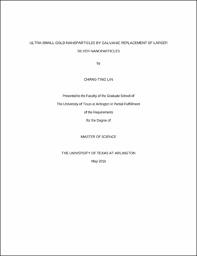
ATTENTION: The works hosted here are being migrated to a new repository that will consolidate resources, improve discoverability, and better show UTA's research impact on the global community. We will update authors as the migration progresses. Please see MavMatrix for more information.
Show simple item record
| dc.contributor.advisor | Hao, Yaowu | |
| dc.creator | Lin, Chang Ting | |
| dc.date.accessioned | 2019-05-28T21:20:09Z | |
| dc.date.available | 2019-05-28T21:20:09Z | |
| dc.date.created | 2019-05 | |
| dc.date.issued | 2019-05-16 | |
| dc.date.submitted | May 2019 | |
| dc.identifier.uri | http://hdl.handle.net/10106/28116 | |
| dc.description.abstract | In the last two decades, Au nanoparticles have been extensively explored for their biomedical applications, which is mainly driven by their biocompatibility and special optical properties known as surface plasmon resonance (SPR) effect. A variety of Au nanoparticles with different sizes and shapes have been synthesized and tested both in vitro and in vivo. For in vivo applications, it is usually required that Au nanoparticles can be cleared through urine (renal clearance). Renal clearance is determined by several factors of Au nanoparticles, including size, shape and surface modification.
In this thesis, for the purpose of using Au nanoparticles as carriers to carry radioactive isotopes such as Cu-64 or Pd-103 into human body for cancer imaging and treatment, we developed a process to synthesize, functionalize and be labelled with Cu of ultra small Au nanoparticles.
We developed an easy and fast way to synthesize ultra small Au nanoparticles with an average diameter less than 5 nm using galvanic replacement reaction to replace spherical Ag nanoparticles with Au chloroaurate. This synthesis process can be completed within an hour at room temperature. To ensure the renal clearance property, Au nanoparticles with size less than 2 nm have been successfully isolated from synthesized Au nanoparticles.
The renal clearance of the nanoparticles are also strongly related to the surface chemistry of the nanoparticles. The Ag nanoparticles we used for the synthesis of Au nanoparticles have
polyvinylpyrrolidone (PVP) coating on the surface. PVP is not an ideal surface coating for renal clearance. Therefore, we first introduced a simple way to remove the PVP coating by washing the particles with acetone. Then the surface of the Au nanoparticles was functionalized with glutathione which has been proven to be a good surface coating for renal clearance.
In addition, we have incorporated Cu on to the surface of these Au nanoparticles using the electroless deposition process, creating a protocol for the radiolabeling of Au nanoparticles. | |
| dc.format.mimetype | application/pdf | |
| dc.language.iso | en_US | |
| dc.subject | Ultra small gold nanoparticles | |
| dc.subject | Galvanic replacement | |
| dc.subject | 2 nm | |
| dc.subject | Copper incorporation | |
| dc.subject | Glutathione functionalized | |
| dc.title | ULTRA-SMALL GOLD NANOPARTICLES BY GALVANIC REPLACEMENT OF LARGER SILVER NANOPARTICLES | |
| dc.type | Thesis | |
| dc.degree.department | Materials Science and Engineering | |
| dc.degree.name | Master of Science in Materials Science and Engineering | |
| dc.date.updated | 2019-05-28T21:20:09Z | |
| thesis.degree.department | Materials Science and Engineering | |
| thesis.degree.grantor | The University of Texas at Arlington | |
| thesis.degree.level | Masters | |
| thesis.degree.name | Master of Science in Materials Science and Engineering | |
| dc.type.material | text | |
| dc.creator.orcid | 0000-0003-1912-7303 | |
Files in this item
- Name:
- LIN-THESIS-2019.pdf
- Size:
- 2.835Mb
- Format:
- PDF
This item appears in the following Collection(s)
Show simple item record


